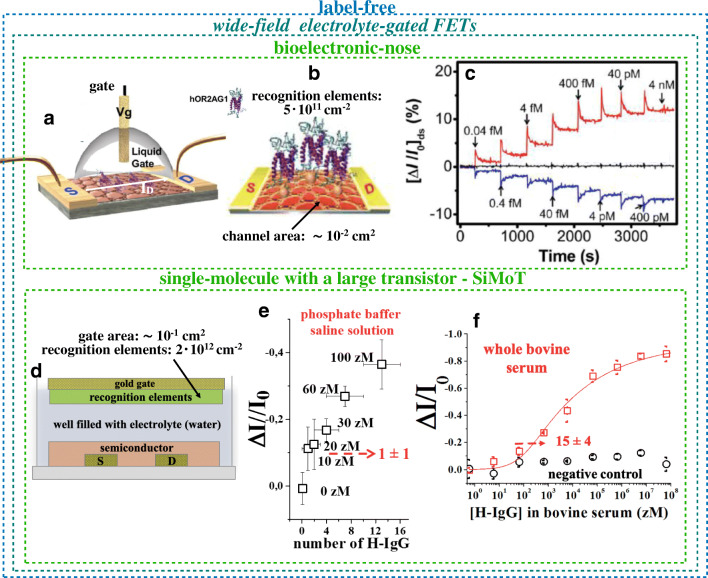Fig. 4.
Wide-field electrolyte-gated FETs. a Electrolyte-gated FET bioelectronic nose sensor based on plasma-treated bilayer graphene whose outmost surface is conjugated with human olfactory receptors 2AG1 (hOR2AG1). b Picture detailing the biofunctionalized graphene FET channel (region between source and drain contacts) whose area is ca. 10−2 cm2. The density of hOR2AG1 receptors is ca. 5 × 1011 cm−2. c Responses as the fractional change of ID, ΔI/I0, of the bioelectronic nose upon exposure to different concentrations of the amyl butylate odorant. The red line is measured on an oxygen-plasma-treated graphene surface while the blue line is relevant to an ammonia-plasma-treated surface. The black trace is the response of pristine graphene. (Panels a, b, and c are reprinted with permission from Ref. [33] Copyright 2012 American Chemical Society). d Schematic of the single molecule with a large transistor (SiMoT) device structure; the gold gate area is ca. 5 × 10−1 cm2 while the density of anti-human immunoglobulin G is ca. 2 × 1012 cm−2. e Human immunoglobulin G (H-IgG) curve in phosphate-buffered saline solution in the 0–100 zM range is shown as the fractional change of ID, ΔI/I0. The x-axis bars are the Poisson errors while y-axis ones are the reproducibility errors. f Dose curve of human immunoglobulin G added into whole real bovine blood serum (red squares) in the 0.6 zM to 6 × 107 zM range. In the control experiment human immunoglobulin M was used (black circles) in place of the specific recognition element anti-human immunoglobulin G used for the sensing. The continuous red line is the result of the modelling based on Poisson distribution probability, which is suitable to account for single binding events. All the data points are the average over three replicates measured on different gates and different transistors. Error bars are taken as one standard deviation. (Panels d and f are reprinted with permission from Ref. [35] Copyright 2018 Springer Nature)

